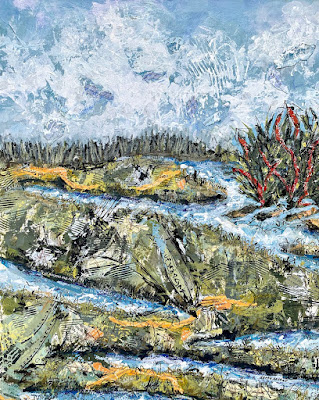Glaciers scoured the Northern Massachusetts coast thousands of years ago and mud, silt, and clay sediments settled out of the water to form extensive mudflats in many of the protected areas of the coast. Twice a day at low tide, in what became a perpetually repeated process over millennia, portions of these mudflats were exposed to open air. Seeds from Spartina alterniflora and Spartina patens took root in the mud. As grasses sprouted and spread through underground rhizomes, the thick growth began to trap more sediments and organic matter which raised the level of the marsh. The organic matter and dead spartina grasses accumulated underneath the new growth as peat. Over time, rich, complex, interconnected living ecosystems evolved.
Um, is it just me, or does this sound like my painting process?!
 |
| You Need Only Breathe In, Breathe Out 10.5 x 13.5"; acrylic, latex, ink, collage, and oil pastel on drawing paper abstract landscape 2019 |
4 comments:
Dotty's Salt Marsh Painting Process! Trapping organic matter, creating complex ecosystems - Yes!!!
Jen, so glad you 'get' Dotty's Salt Marsh Painting Process! It was so funny to read about salt marshes and realize, huh!, Wikipedia is actually talking about my painting process!
Absolutely!I love your metaphorical references. Laying down marks, washing over, scrubbing sometimes, and then more adding, washing and scrubbing! Wow what textures!
Carol, thanks for the nod to my metaphorical fancy—doesn't it sound just like the painting process?! I laughed out loud!
Post a Comment